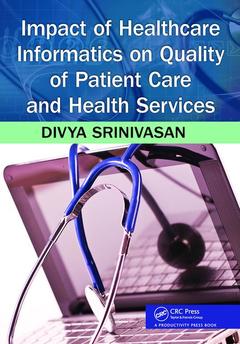Impact of Healthcare Informatics on Quality of Patient Care and Health Services
Auteur : Srinivasan Sridhar Divya

Recent healthcare reform and its provisions have pushed health information technology (HIT) into the forefront. Higher life expectancies, fewer medical errors, lower costs, and improved transparency are all possible through HIT.
Taking an integrated approach, Impact of Healthcare Informatics on Quality of Patient Care and Health Services examines thevarious types of organizations, including nonprofit hospitals, for-profit hospitals, community health centers, and government hospitals. By doing so, it provides you with a comparative perspective of how different organizations adapt and use the technology.
The first part of the book covers the basics of HIT. It explains the significant changes that the Health Information Technology for Economic and Clinical Health Act (HITECH) and the Health Insurance Portability and Accountability Act (HIPAA) will bring about for stakeholders. This section includes coverage of key organizational cultural factors, management changes that will result from HIT, hospital financing changes that may take effect, a cost-benefit analysis of electronic medical records (EMRs), and the numerous organizational behavior changes stimulated by HIT.
The second part of the book focuses on the broader community: the patient, the physician, government, and how HIT will impact each.These chapters cover quality of care and cost impacts on the patient from HIT, changes for patients of varying socioeconomic statuses, physician perceptions of HIT, medical malpractice lawsuits involving the use of HIT, bioterrorism, and use of EMRs. The book also includes a discussion about mobile health, and how a rapidly growing mobile health generation is changing the face of healthcare as we know it.
HIPAA: Intent versus Actuality of the Law in Upholding the Privacy of Health Records. Organizational Culture Differences in Incorporation of Health Information Technology (HIT) across Healthcare Providers. An Overview of How Health Information Technology Will Make a Mark on Hospital Financing. Funding Electronic Medical Records: Reality or Illusion? A Cost-Benefit Analysis. Impact of Organizational Behavior Characteristics on Usage of a Healthcare Provider’s Health Information Technology (HIT) Services. Quality of Care and the Patient. Physicians and Perceptions on HIT Medical Malpractice Lawsuits: Can Physicians Reduce Their Chances. by Using Health Information Technology? Community Impacts from the Detection of Bioterrorism Using EMRs. Health Informatics and the New Direction of Healthcare: Mobile Health, PHRs, Mobile Health Apps, and More.
Date de parution : 11-2017
17.8x25.4 cm
Date de parution : 03-2013
17.8x25.4 cm
Thèmes d’Impact of Healthcare Informatics on Quality of Patient... :
Mots-clés :
HITECH Act; EHR; Funding Electronic Medical Records: Reality or Illusion? A Cost-Benefit Analysis; EMRs; Quality of Care and the Patient; HIEs; Community Impacts from the Detection of Bioterrorism Using EMRs; EMR System; Studies on Malpractice Concerns; HIMSS Analytics; Descriptive and Inferential Statistics; EMR Usage; Ceo Compensation; Government Hospitals; Health Informatics; Charity Care; AHRQ Publication; Medical Malpractice Lawsuits; Medical Malpractice; Automated Reporting Systems; Chess; EMR Adoption; Multinomial Logistic Regressions; EMR Technology; Patient’s Zip Code; Vodafone Foundation; Hit Integration; Medical Malpractice Suits; Net Benefit; CDSS



